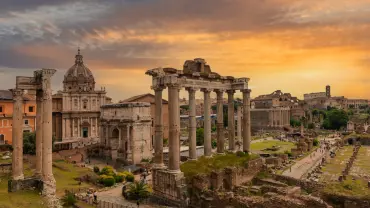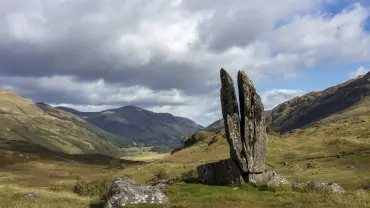Scattered among the low foothills and upland valleys of the Xiangkhoang Plateau in northern Laos lies a haunting tableau of megalithic proportions. The Plain of Jars is one of Southeast Asia’s most important archaeological sites, yet it remains shrouded in mystery.
This most fascinating field of jars comprises over 2,000 cylindrical stone vessels which may have been put in place over 3,000 years ago. They vary in size from around one to three metres tall and stand in clusters, or sites. Some sites have just one jar, others as many as 400, and it’s been reported that the total area of the Plain of Jars covers something like 90 square kilometres.
Since the 19th century, when the site was thrust into the international arena, theories abound. Were they nothing more complex than stores for grain or wine? Were they funerary urns? Was the field of jars Laos’s position on a complex trade route?
Or, were they, as some legends suggest, drinking vessels for a mythical race of giants to celebrate victory in battle?
These, and many other questions about this megalithic stone jars mystery add to the intrigue surrounding the Plain of Jars. Let’s take a trip to Laos, the only landlocked country in Southeast Asia, in an effort to shed light on these curiously colossal cups.
The Discovery of the Plain of Jars

A close-up of the Plain of Jars in Laos. (Credit: Image Source via Getty Images)
The Plain of Jars in Laos has been known to local populations for centuries, but it gained wider international attention in the nineteenth century, largely due to French explorers, archaeologists and researchers who undertook archaeological excavations in the region. During this period, they began documenting and studying various aspects of Southeast Asian history and culture, including the mysterious Plain of Jars.
In the 1930s, more systematic archaeological studies were conducted, aimed at uncovering the origin, age, and purpose of the jars. French archaeologist Madeleine Colani, who remains, over eighty years after her death, one of the world’s most important sources for today’s comprehensive understanding of the megalithic stone jars mystery, believed they were funeral urns for local chieftains or leaders. The presence of human remains in and around the jars dating from around 500 BCE to sometime after 500 CE led her to believe they were vessels for the departed, but her findings, while plausible, were far from certain.
Further excavations in the 20th century by archaeologists and geologists from around the world go a long way to support Colani’s hypothesis, but there are a number of alternate theories which challenge this view and offer varied interpretations of the jars’ purpose and origin.
The Colossal Stone Jars

Plain of Jars in Laos. Their usage is still a mystery (Credit: joakimbkk via Getty Images)
Sculpted from sandstone rock, the field of jars, Laos’s most enigmatic and mysterious site, is a mystery that has perplexed the archaeological world for almost a century.
Almost nothing is known about who created them, but it’s believed they were once sealed with lids. Today, just one jar is lidded but other stone discs have been found with bas-reliefs of animals carved into them. The lids may have been made from wood or another material which has long since perished, and all but a single jar, which has a mysterious relief of a humanoid frog-type creature carved onto it, are plain.
The Plain of Jars Theories

The Plain of Jars, a megalithic archaeological site in Laos (Credit: gionnixxx via Getty Images)
The field of jars, Laos’ archaeological marvel, has posed numerous questions that remain largely unanswered. While several theories have been proposed, none have been definitively proven.
Storage for Food or Wine
One of the most common theories is that the jars were used for storing food or wine. This theory is grounded in the idea that such large containers would have been ideal for storing surplus grains or for fermenting and storing rice wine.
Burial of Funereal Use
Another widely supported theory is that these megalithic stone jars were used for funerary practices. Archaeological evidence, including the discovery of human remains and burial goods in and around some of the jars, supports this theory. It’s believed by some that the jars might have been used to expose the dead temporarily before their final burial, a practice known in archaeology as secondary burial.
Collection of Rainwater
Some scholars propose that the jars were used to collect and store rainwater for caravan travellers moving along ancient and long-forgotten trade routes. This theory aligns with the strategic locations of the Plain of Jars sites, often found on elevated areas or along potential travel routes through the region.
Trade Route Markers
Building on the idea of caravan travellers, another theory suggests that the Plain of Jars was a part of a more extensive trade network, specifically, according to Madeleine Colani, the trade of salt in the region. This is supported by the discovery of items such as beads and ornaments from different regions, possibly indicating some level of trade and cultural exchange. The jars themselves, under this theory, could have been central to the trade network, perhaps between the Mekong River Basin and the Gulf of Tonkin.
A Mythical Race of Giants
Some legends add a mythological dimension to the various Plain of Jars theories, suggesting they were created by a race of giants and their king, Khun Cheung. The story goes that these giants used the jars to brew and store huge quantities of rice wine, known locally as lau hai, to be drunk in celebration of a great victory. While this theory isn’t supported by archaeological evidence, it’s a significant part of the cultural and historical narrative surrounding the jars.
There are other, less prominent and more speculative theories as to the purpose of the huge number of vessels in the field of jars, including some sort of ceremonial or ritualistic use, or as status symbols or representations of social ranking.
There’s also speculation that they were used in relation to astronomy, or calendar-type devices used to mark certain celestial events or seasons. They could also be territorial markers or boundary stones, delineating specific areas, or, given the age and the mystery surrounding the jars, they might have held religious or spiritual significance that is not yet understood, possibly related to ancient belief systems or practices which have been lost to history.
These additional theories, while not as widely supported or documented as the main lines of enquiry, add to the complexity and intrigue of the Plain of Jars in Laos. They demonstrate the wide range of possibilities and interpretations that archaeologists and historians consider when trying to understand such enigmatic ancient artefacts.
The Plain of Jars Mystery

The Plain of Jars, a testament to the enduring enigma of our ancient world (Credit: @ Didier Marti via Getty Images)
In the heart of Laos lies a riddle etched in stone – the Plain of Jars. These ancient containers, grand in scale and enigmatic in purpose, continue to captivate and mystify. From theories of funerary practices to the grandiose legends of giants, the megalithic stone jars mystery stands as a silent testament to a forgotten era. As archaeologists and historians piece together the puzzle, the Plain of Jars remains not only a symbol of Laos’ rich heritage but also a reminder of the profound mysteries that our ancient world still holds.












